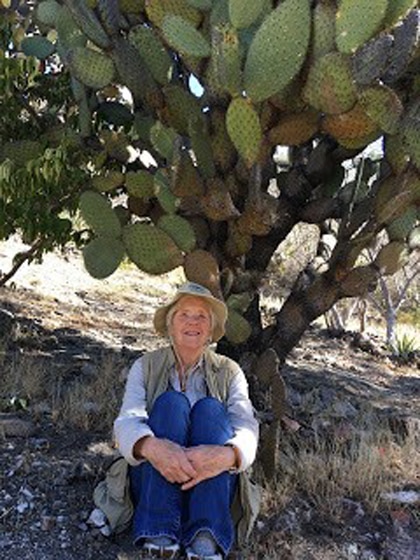The Sights, Sounds, Tastes, and Birds of Oaxaca
Editor’s Note: Want to experience the birds of Oaxaca in person? You can! We have spaces available on our December 2019 trip. For more go to goldengatebirdalliance.org/travel
By Julie Stokstad
Photos by Julie and Bob Stokstad
Home again, and the wonderful trip to Oaxaca is like a dream. On the trip we saw 230 different species of birds and learned about the rich culture of Oaxaca, ate great food and enjoyed the gracious hospitality of our Mexican hosts. It’s been one of our best trips ever. As I think about why I loved it so much, Mark Pretti is a big part of it. His enthusiasm and skill in finding the birds and stories made the trip for me. Mark shared with us such interesting information about the birds, plants, insects and reptiles we saw. He was curious and he cared about nature and that made me care about everything we saw.
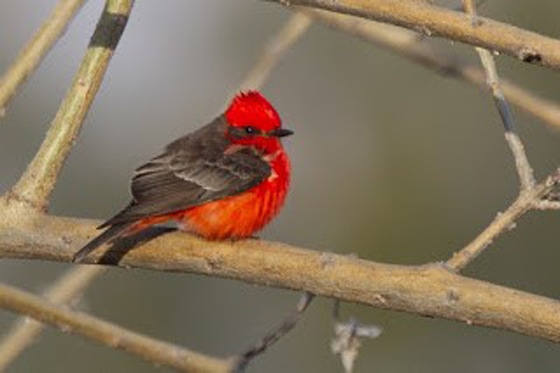
Day 1 – Birding, Weaving and Food
The day began at breakfast at 6:15 am. The stars were still out and it was chilly on the roof terrace, but hot coffee and a lovely breakfast nourished us. It was a 45 minute drive to our first stop – a grassy hillside in the foothills above the Oaxacan valley. Along the way Mark talked to us about the biogeography of the region and the various habitats we’d visit. We saw many birds (Vermillion Flycatcher, endemic Gray-breasted Woodpecker, Lark Sparrow, Inca Dove, Curve-billed Thrasher, Rufous-capped Warbler, White-throated Towhee and more) and learned about the cactus and trees growing in the area. We learned about which birds eat what and where and when to expect them (when their food source is ripe). After a couple of hours, we drove to a small creek spotting a variety of birds there – lots of flycatchers and warblers. The morning held yet another habitat – a small lake behind a dam. There I spotted a Berylline Hummingbird, Ruby-throated Hummingbird, Dusky Hummingbird and many of the usual suspects for lakes (Egrets, Coots, Sandpipers, Killdeer and Least Grebes). For lunch we drove into town – Teotitlán Del Valle – a small thriving Zapotec community where many weavers live and work. We chose from a menu of local foods – Mole negro, Mole coloralitos and hulaypo (Oaxacan pizza).

After a relaxed lunch (birders never hurry at lunch), we went to a local weaver and had a fabulous demonstration of natural dyeing and spinning and weaving.
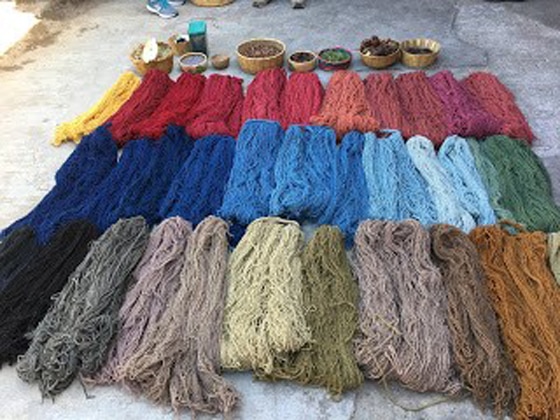
As we sat in the shade in their courtyard, we were given a local drink – Atole – which is made from roasted corn ground into powder and diluted with water. The day ended with a stop at the Biggest Tree on Earth – a Montezuma cypress which is 2000 years old. In the 19th century Alexander von Humboldt came all the way from Germany just to see this tree, it’s that famous.
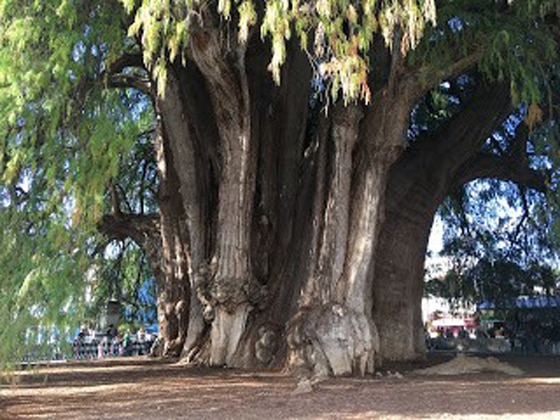
Day 2 – La Cumbre in Sierra Norte
Today we went up into the Sierra Madre Mountains north of town to tromp around in the high forest (8000 to 9000 ft.) and find birds. Mark’s enthusiasm, expertise and funny stories made the whole experience a great pleasure. About 25% of Mexico is forested, with the Sierra Madre Mountain running north to south like a spine in the middle of the country. Oaks and pines are the dominant species and there are more than 50 kinds of pines and more than 100 kinds of oaks. In addition there are lots of Agaves in the forests which look strangely out of place to my eye.
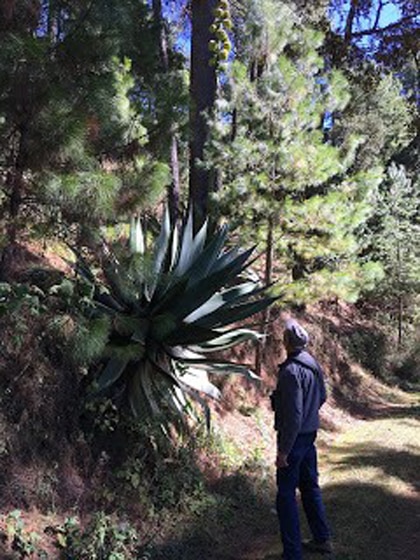
We’d been warned to wear all the layers we brought, but luckily it was a beautiful day. On the way up, we stopped and walked up a dirt road looking for the Oaxaca Sparrow. We found a pair of them plus a Boucard’s Wren, Greater Peewee and a number of flycatchers that were hard to identify. Mark explained the difference between bearded and non- bearded flycatchers. The bearded ones use those feathers around their beaks and their thick big bills to catch large flying insects, while the non-bearded ones typically glean insects from trees and bushes. For the non-bearded, to try to catch large insects would be “like me trying to catch butterflies with a goldfish net.” We learned that habitat, size, shape, and behavior are better for identifying birds than color markings. As we walked through this rich bird habitat, we saw Bullock’s Orioles feeding on the nectar of the large white flowers of the morning glory tree. We watched as they pecked a hole in the bottom of the flower to gain better access to the nectar, by-passing the pollen. Too bad for the flower as it gave up its bribe of nectar and didn’t get pollinated. Other birds worth mentioning among the many we saw were Rivoli (Magnificent) Hummingbird, Blue-throated Hummingbird, a brief view of a Mexican Violetear, Bumblebee Hummingbird, a couple of Green Elaenia, a sulky Elegant Trogan and a Blue Mockingbird. There were lots of wildflowers along the path which was somewhat surprising since it hadn’t rained for many months. Some are common in the U.S., like lupine, Indian paintbrush, thistles, but by far the most common were Salvias (Mexico has more than 300 species). The trees were dotted with epiphytes – bromeliads, mosses, lichens. I got some great views of the Slate-throated Redstart as well as a White-eared Hummingbird.
The high point of the day for me was lunch at a beautifully situated restaurant called Colibri (hummingbird in Spanish) overlooking the forest. The walls of the restaurant were open to the forest and there were hummingbird feeders hanging all around, with lots of hummingbirds zipping in and out of the nearby flowering bushes. Here we saw a Long-billed Starthroat, as well as a Gray-barred Wren. We took our time over lunch and after nearly two hours, most of us got into the van, everyone except the driver Benito. Finally he came and got us. There was a warbler bird party. We got amazing looks at a beautiful bird, the Olive Warbler, which isn’t olive and not a warbler. There were at least 7 different species of warblers there! On the way back to our lodging we found wonderful birds wherever we stopped.
Day 3 – Oaxacan Food and Culture
This morning we went to the huge Central Market of Oaxaca, Mercado de Abastos. The sign above the entrance read “Todo de Todo y Mucho Mas….” and there was. Because it was 9:30 am on Sunday morning, the market was very quiet. It was a total sensory experience, amazing delights to see, overwhelming smells, tastes of amazing local food, and sounds of local culture. You could buy anything you wanted or needed there, well maybe not electronics. There was every kind of ingredient from dried grasshoppers to chilies to garlic, from breads to fresh yellow skinned chickens, fresh and dried fish and much, much more. I’ve never experienced a market where we went from place to place tasting everything. We started with cacao beans which were ground with stick cinnamon and almonds into a shiny dark brown paste. We watched the young girl make Mexican hot chocolate, using the paste mixed with sugar and boiling water.
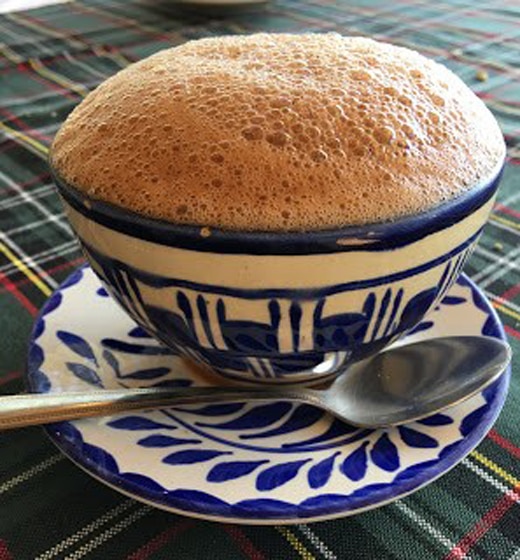
The next was maybe the best—the Oaxacan tamales. They cost 5 pesos each (about 25 cents). We all got plastic forks and passed the three different kinds of tamales around. Muy delicioso!
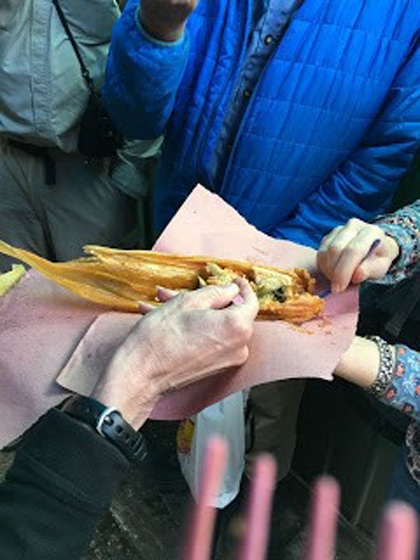
We wandered for hours, past the herbalists with cures for almost anything and the fish sellers, and went down bread alley. We spent a long time by the dried chilies learning from our guide about each variety’s flavors and which chili is used in which dish. There are so many different kinds!
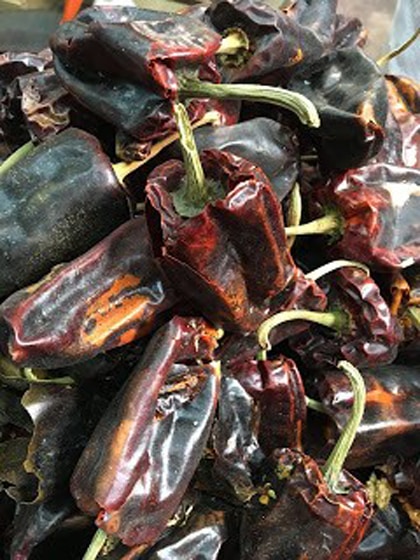
I was impressed by one woman selling all the ingredients for a yellow mole (the right chilies, flowers, herbs, what looked like prickly pear pads and long brown pods with dark seeds and tortillas). Last, but not least, we tasted Tejate, an ancient drink of the local peoples around here. It has a base of roasted corn, cacao, flowers, Mamey fruit and a kind of coconut all ground together and then whipped into water. It’s amazing that a drink that Zapotecos have had for thousands of years is still sold in the market today. I liked it!

Next, we drove north into the countryside to the Seasons of the Heart Cooking School. It was started many years ago by an ex-pat American chef, Susanna Trilling. We learned about all the local cooking implements and ingredients used to make the meal. Then we were treated to a delicious five course meal. But first we were invited to help prepare the tetelas, tasty appetizers of bean paste spread on a tortilla, folded into a triangle and then cooked on a copal (a big metal dish) over an open fire. Sopa de Ajo was our second course, followed by a delicious salad with jicama, citrus, avocado, pomegranate, and a variety of greens. The main course was mild mole with chicken and finishing the meal with a bread pudding. It was interesting to spend a day concentrating on food because it is truly the sustenance at the basis of our lives. Interesting to think how connected the local people are to their land. Interesting to think about the birds we’re here to see and how they have interacted with their food supply. Interesting to think the role food has played in the successful adaptations we see.
Day 4 – Monte Alban Ruins
As we drove to the Monte Alban ruins we learned that the mountain top was purposefully flattened over a period of 200-300 years before the Zapotecos began to build their pyramids, houses and grand sites on the mountain top. Our co-guide Benito was passionately proud of his Zapotecan heritage and shared many stories about the society that lived and ruled here from 500 B.C. to 750 A.D. We learned that it was an advanced society with medicine, arts, music and complex administration. I photographed wildflowers whenever I saw them. I was excited to see the “bloody nose plant” (Calliandra) that I know from our Botanical Gardens. I learned from Mark that it is bat pollinated and makes new flowers each night with fresh pollen to attract the bats. Mark also told us about how the Zapotecos (then and now) soak and then cook their corn with a little piece limestone which helps dissolve the seed coat of the corn and releases the vitamin B12 which is essential for good health.
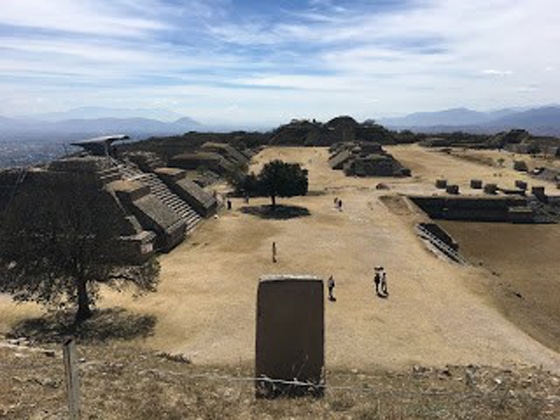
We had a picnic lunch in the shade and then toured the Museo de las Culturas de Oxaca (with great views of the adjacent botanical garden and its many birds). Perhaps the most interesting display case was one showing human skulls which had been modified surgically to have the shape of a panther (presumably while the person was alive).
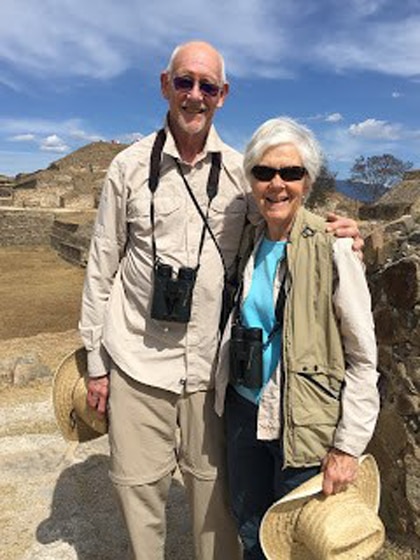
Day 5 – Yagul to Sierra Miahuatlan
We left Oaxaca and walked a rural road, looking for birds. It wasn’t hard, birds were everywhere. The early morning light gave a golden glow to the world. It took us nearly 2 hours to walk a mile on the road, there was just that much to see. I listed 30 different species but there were even more that others saw. The first birds I saw were blue, very blue —-the Blue Grosbeak and the Indigo Bunting, both eating seeds from drying sunflowers. My favorite bird was the Loggerhead Shrike, a thick billed biggish white bird with gray markings. It flew over our heads and was gone, then reappeared carrying a big lizard. It then disappeared behind some brush and reappeared without the lizard. Then another shrike flew in and they both disappeared behind the brush. One of them flew out carrying the lizard. Mark said they must be a resident pair — the male hunting and then giving the food to his mate. The morning made for happy birders.
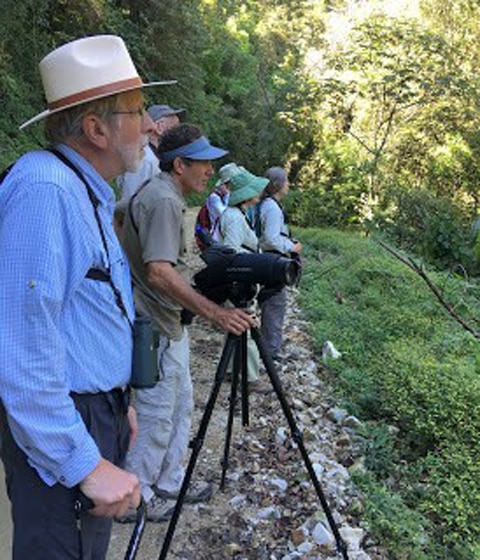
We then walked up the road to Yagul a Zapotec and UNESCO World Heritage Site. Benito walked us through the site, giving an excellent history and current information about land use in the Oaxacan Valley. Next we stopped at the workshop and home of some alebrije (wood carving) artists, Zeny y Reyna Fuentes. We learned about the wood carving process and watched them do their carving with just a few simple tools. The wooden animals are then expertly painted using Agave spines by Reyna and her daughters. It was hard to choose what to buy, there were so many beautiful little and bigger animals.

Day 6 – Sierra Miahuatlan to Rancho Cerro Largo
We started out birding around the hotel at 8000 feet It was a balmy warm morning and plenty of birds were in the trees and underbrush. Of the 18 species we saw in less than an hour, warblers, tanagers and orioles were the most common. The last place Mark took us was the Monkey Hand Tree. I called it “Bird Candy Tree” because the large cups of the flowers were full of nectar, at least 1/2 inch deep. We tasted it and found it sweet, tasting of brown sugar. The tree makes fresh flowers and nectar every morning. Warblers, tanagers, orioles, hummingbirds, robins and a Hairy Woodpecker were flitting in and out. After we left the hotel, we stopped on a dirt road at about 7500 feet where there were hummingbirds. We watched Bumblebee and Blue-capped Hummingbirds doing their thing, feeding, singing and defending territory. The forest was full of flowers and birds. We watched a Cinnamon-bellied Flowerpiercer stealing nectar from the base of red salvia flowers, a nectar parasite.
Further along at our lunch stop, we saw several more hummingbirds, including the Long-billed Starthroat. Our last stop was along a dirt road in a broadleaf forest around 4000 feet elevation. In shady areas, there were elements of a cloud forest, with large philadendron and gigantic tree ferns. Here we searched for Northern Emerald Toucanets. Looking for these green birds among the tall densely packed dark green trees was truly like looking for a needle in a haystack. I enjoyed the little waterfall and the mossy green banks covered with ferns and little begonias, lichens and liverworts. We spotted the “bird of the day” last—a Flame-colored Tanager. It was fairly large, bright orangey-red and stunning, especially against the green of the trees.
Day 7 – Rancho Cerro Largo and Finca El Pacifico
In the early morning light, after coffee, tea and cake, we walked along the road for an hour seeing some good views of birds. But the best was after our breakfast around 10 o’clock. Ten feet in front of us were 5 very beautiful birds – a Citreoline Trogan, a Rusty Mot-mot, White-throated Magpie Jay, Orange-breasted Bunting and the Colima Pygmy Owl. Later we also saw a Brown Booby on an offshore rock, Red-billed Tropicbirds, Squirrel Cuckoo, Cinnamon and Broad-billed Humingbirds and Short-tailed Hawk. Then we had 4 free hours to relax, go to beach to explore and swim and let the magic of this special place do its work.
Bob and I put on our bathing suits and headed for the beach. There is a steep stone path down the cliff to the beach. The water was warm, the waves medium sized and the beach nearly deserted. Lying in the porch hammock, back in our cabana, I drifted in and out of sleep watching the soaring black frigatebirds, turkey vultures and brown pelicans. After a lunch of tostadas with guacamole and fresh fruit, we slowly made our way to a small fishing village called Ventanilla. The birding was excellent as we walked through the village with the sun at our backs. The forests were full of flowers and colorful birds and butterflies.
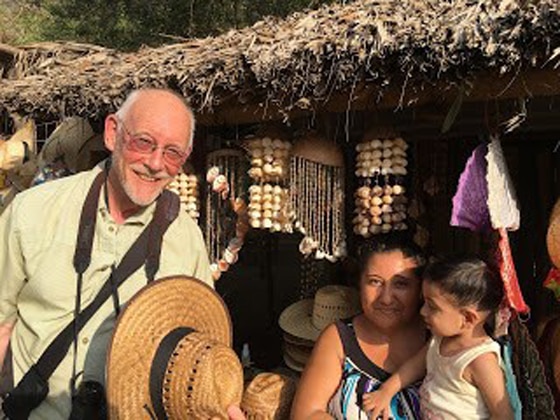
Day 8 -Ventanilla and Coffee Plantation
We went back up to the broadleaf evergreen forest and walked a road where coffee bushes have been planted in the deep shade. It was a riotous time of birding with the forest full of birds, most of them directly overhead 30 feet above us. I recorded 30 species, including Masked Tityra, Golden Vireo, Magnolia Warbler, Audubon Oriole, Dusky-capped Flycatcher, Collared Trogan, Rose-throated Becard, Brown-crested Flycatcher, Boat-billed Flycatcher and Yellow-winged Cacique. My favorite, and that of the birds, was the gumbo limbo tree full of fruit. It has shiny red bark like the madrone that grows in Northern California forests but it is much bigger.
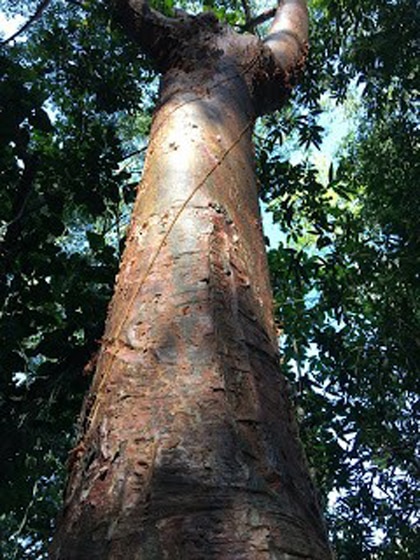
What was remarkable during this time were the stories Mark told. He waxed eloquent about a termitory (a mud termite nest up in a tree). He pointed out the mud tubes running down the tree. He had us guess why termites went to that much trouble and then explained, when none of us had the right answer, that termites have very thin exoskeletons and use the tubes to keep up the humidity so they don’t dry out. The tubes are built of termite poop, mud and leaf litter. Then he gave us an interesting explanation about wood and how the termites digest it. Wood is made of cellulose and lignin, cellulose being the rebar and lignin, the cement. Termites have protozoan with bacteria in the gut that digest cellulose but for millions of years nothing could break down lignin. That’s where our carbon energy comes from. We stopped at Finca el Pacifico for our picnic lunch and a tour of this organic-certified shade grown coffee plantation. Antonio is the 4th generation to run this finca. They sell all their beans to Mexicans who are increasingly buying special coffee. Back at Cerro Lago we went for a walk on the beach at sunset.
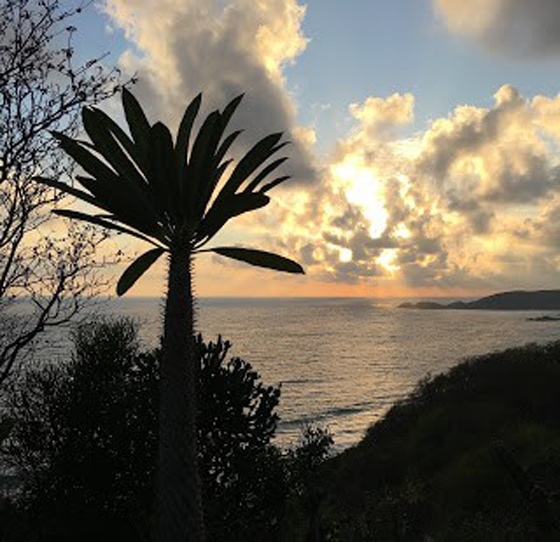
Curiously, because of the lay of the land, standing on the shore in the evening, one has only to look to the left to see the sun setting over the water, and in the morning look right to watch the sun also rise over the water of the Pacific Ocean. This evening the golden light made the beach, the cliffs and the water magical. I looked back over the hillside cliff we had walked down and had trouble locating the palm thatched roofs of our cabanas. Cerro Largo is tucked away so it is one with nature, truly an eco-lodge. Over the days we were there, I found myself becoming one with Cerro Largo and its beautiful natural setting. I loved our wall-less cabana with its view out to the ocean I loved the delicious vegetarian food, especially the Huevos Rancheros for breakfast. And of course, the birds were great.
Day 9 – To Puerto Escondido
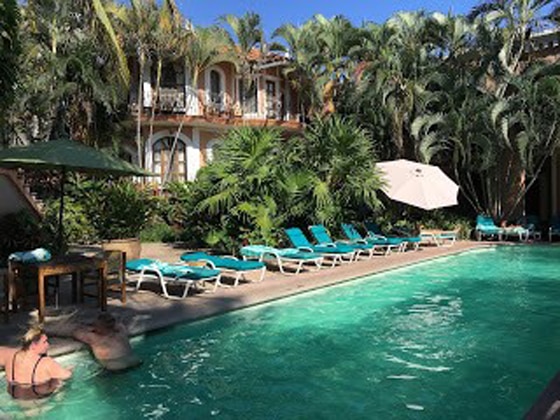
After birding and breakfast, we departed to drive 1 1/2 hours north to Puerto Escondido. Our hotel room was large with a hammock stretched right across the middle and a king size bed too. After a late lunch and a rest, we departed for a late afternoon visit to Rio Colotepec, a nearby estuary, to see the water birds. We parked at the end of a long dirt road at the edge of a wide sandy beach and hiked maybe a 1/3 mile through the sand to the river bank. There, we watched a multitude of waders, ducks, and terns (Black and Sandwich) crowding on to a sand bank in the river. I especially liked watching the Ruddy Egret, a tall gangling bird flopping around in what seemed to me a dance to some inner music. It moved back and forth opening and closing its wings and lifting and shuffling its feet to stir up food in the shallow water.
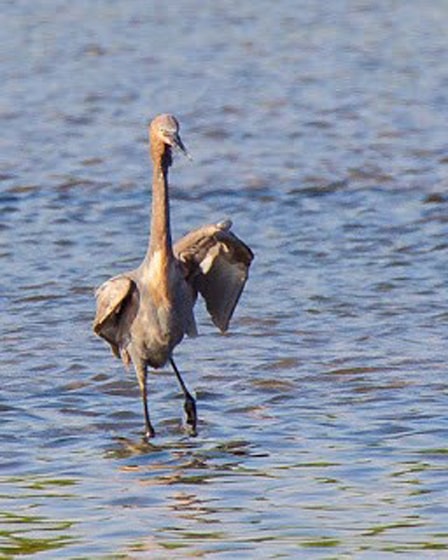
A flurry of Snowy Egrets began shuffling their feet and waving their wings, scooping them down to the water herding fish to shore exhibiting communal cooperative behavior with Little Blue and Tricolor Herons helping out. As the sun began to set, we walked back, returning by the ocean where one of our group spotted two kinds of plovers, including Collared, on the berms of sand. Our long shadows amused us and we assumed silly positions to take photos.
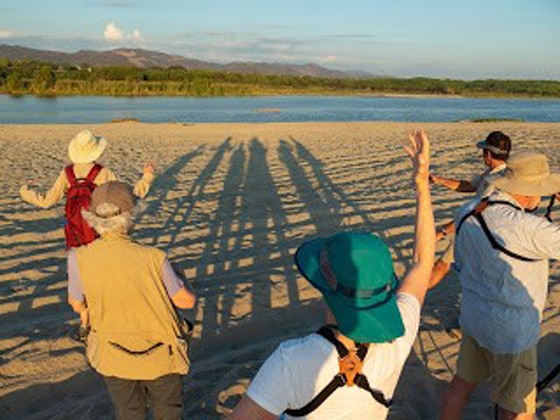
We trudged back to the van in the golden light of the day’s end. We watched the birds flit in and out of the scrubby trees near our van on their way to roost in the trees or the nearby cattail marsh. I loved the Scissor-tailed Flycatchers, with their long tail feathers, sitting at the top of a tree bathed in golden light.
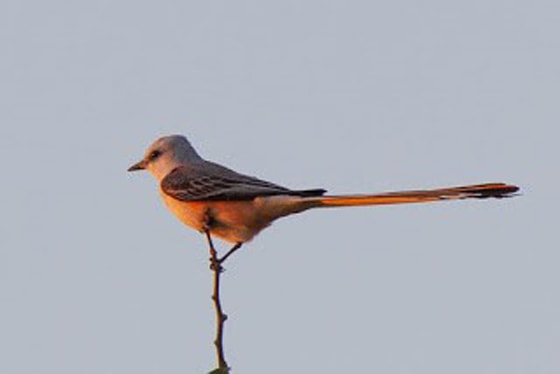
Day 10 – Laguna Manialtepec and Return Home
We were in the van by 6:30 to make it to Manialtepec Lagoon by 7 when most birds start to get active. It is a large beautiful red mangrove lagoon. As we arrived we spotted a colorful Citreoline Trogon with its tiny feet on a nearby tree.

Then we got on the boat outfitted for sightseeing with five seats on each side of the boat so no one had an inside seat! The morning light was beautiful and we soon began to see birds perched in the mangroves and flying over: a sleeping nocturnal Boat-billed Heron, Green, Amazon, Ringed and Belted Kingfishers, Groove-billed Ani, Bare-throated Tiger-heron, Mangrove Cuckoo, Anhinga, Osprey, White Ibis, Crane Hawk, Common Black Hawk and more.
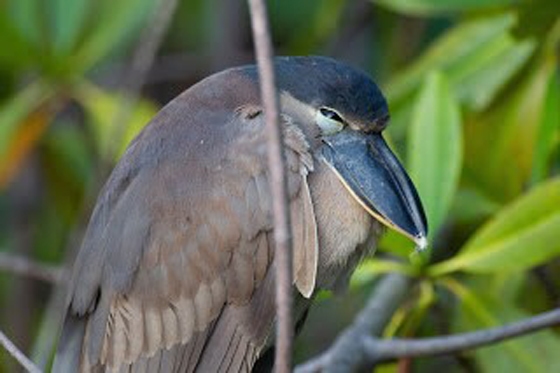
There was a large green iguana lounging in the sunshine on a tree branch. It could lounge worry-free because it’s outgrown all of its predators.

Birding was easy and the large nearby birds weren’t hard to spot. We saw a cavalcade of cormorants (hundreds of them by the edge of the mangroves) that grew increasingly alarmed by our boat and took off as one body with a mighty flurry of splashing water and squawking. As we got near the mouth of the river the water was less brackish and the plants were different. There were grasses, palm trees and water lilies all of which supported more insects, so we got different birds: ducks, moorhens, gallinules and more. We saw a Lineated Woodpecker, the Mexican equivalent of the Pileated woodpecker, vigorously attacking a palm snag presumably full of insects. It was very large and had a great wild red topknot making it look like Woody Woodpecker from cartoons in my childhood.
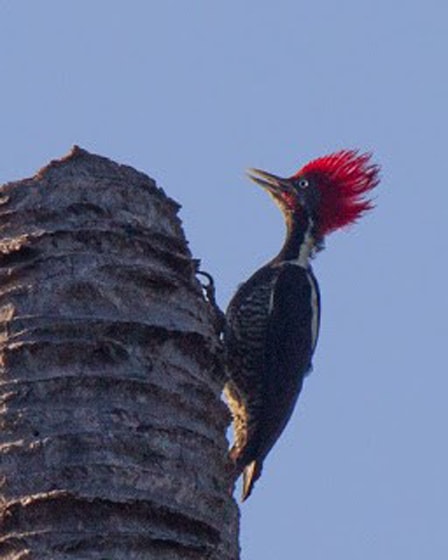
We spent a full 2 hours on the water and for me it was all bliss. Then Mark said, “Hold on to your hats.” and we zoomed back to the dock. I thought, “All this is sacred.” I’m so happy to have experienced such richness and diversity of life with people who also found it sacred (or at least totally wonderful). The boat ride was a “Wow” experience and deep peace and happiness settled over me. Our fellow participants were wonderful: curious, enthusiastic, considerate, and polite. I could not have wished for anything different. I have been so fortunate to have this experience. Now my IPad and my head are full of many lovely images to help me remember it.
Julie is a long time birder and lover of nature. She currently volunteers at the University of California Botanical Garden as a docent and propagator. Julie and Bob especially enjoy traveling on Mark Pretti’s Nature Trips.
